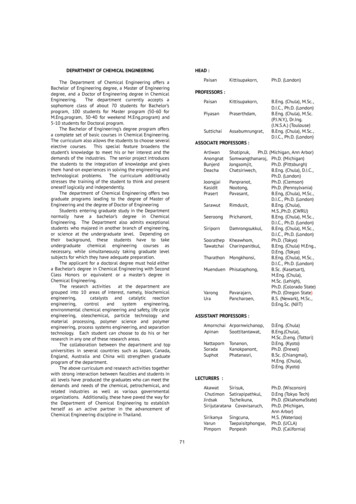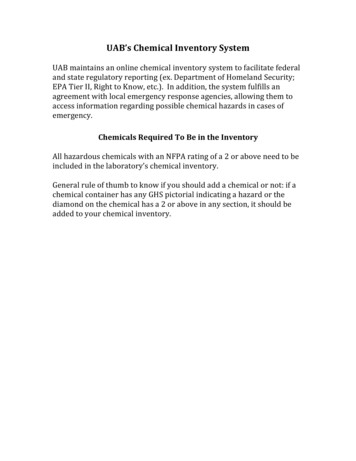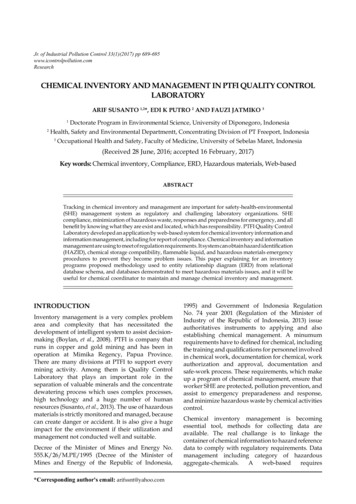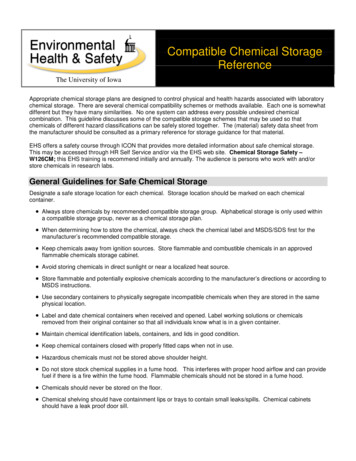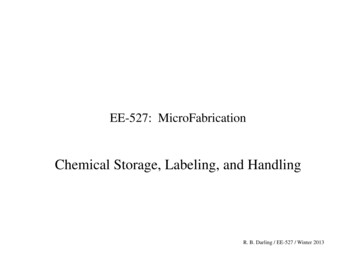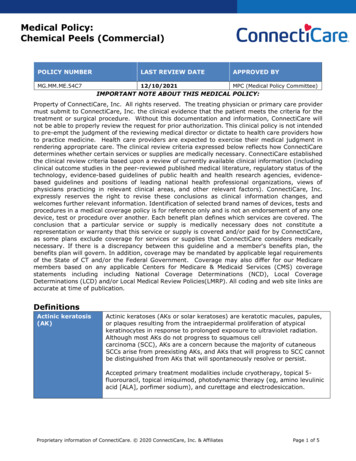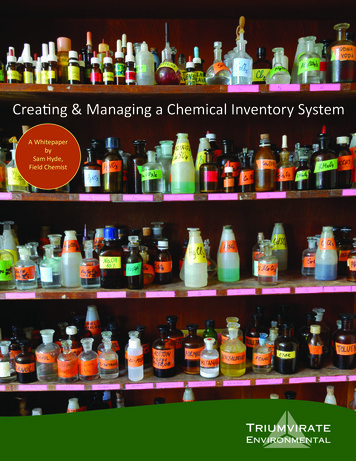
Transcription
Creating & Managing a Chemical Inventory SystemA WhitepaperbySam Hyde,Field ChemistTriumvirateEnvironmental
Creating and Managing a Chemical Inventory SystemBy Sam Hyde, Field ChemistA chemical inventory system is, as the name suggests, a programto track products and their locations throughout a given site.Managing an effective and accurate chemical inventory systemis a crucial part of any robust environmental health and safetyprogram. Whether it is a healthcare, academic, or commercialresearch setting, an investment in a strong inventory programwill pay dividends in safety, compliance, and cost management.However, a considerable amount of time must be invested onthe front end to fully realize these benefits. This whitepaperdiscusses the important issues to consider when developinga chemical inventory program, and the benefits that a robustprogram brings.Program VisionFirst, it is imperative to have someone in a strong leadership role as an executive champion when implementing achemical inventory system. This person, or group of people, should be familiar with the diverse requirements ofresearchers, lab support staff, logistics managers, purchasing, information technology, and compliance officers atthe facility. This leadership is important because chemical inventory sits at the intersection of these groups anda commitment will be needed from all involved. The inventory program should be researched and developedwith input from all stakeholders prior to implementation. It is often tedious to nail down all of these issuesbeforehand, and of course no program survives intact from planning to implementation, but a half-heartedprogram provides no real benefit and can be a drain on time and resources.There are several key issues that need to be decided before any system is put in place.1. Program goals2. Program scopeProgram GoalOutlining the vision of the chemical inventory system is extremely important to gain organizational buy-in. Then,defining the goal(s) of your inventory program is crucial. Do you want a system that enables safety personnel to generate reports of all hazardous chemicals in thebuilding by laboratory? Would you like end users to be able to search for chemicals by individual cabinet, shelf, or bin?The more specific the goals and scope of the program are, the more effectively a system can be tailored to suityour needs. It is easy to lose sight of the forest through the trees. The best way to avoid this is to have a concreteidea of the lifetime of a chemical in the facility. From receiving, it will be logged into the system and deliveredto a certain location. It may be moved from place to place. It will eventually be emptied and logged out ofthe system. How will this best be managed? Keeping an eye on the practical side of the system is absolutelyessential. After all, even the most ambitious program can fall flat if it is impractical in everyday use.
Program ScopeThen, there is the scope of the inventory program. Do you want to inventory: flammable solvents? all hazardous chemicals? all chemicals coming into the facility? kits, which often contain many small bottles? buffer solutions? only stock chemicals? working solutions?The answers to these questions will depend on your program goals and the practical limitations you face.Program ImplementationAfter there is a solid plan for the goals and implementation of the program,it is time to make it happen. The first place to apply the program is at thepoint of entry to the facility. Train your logistics staff on whatever specificsystem you are using, and have them begin tagging every chemical thatcomes through the door on a daily basis. This train and tag system hasdual benefits. One, personnel will familiarize themselves with the systemthrough regular exposure and can quickly spot any glaring problems. Two,this ensures that nothing slips through untagged as existing onsite chemicalsare addressed.Once certain that all new chemicals have been added and tagged, begingoing through the facility laboratory by laboratory (or even bench bybench) and tagging everything that falls within the scope of the program.This process will start slowly, but will speed up as the database grows. Makesure that lab personnel have been trained (or at least made aware of) the program. Let them know their dutiesregarding logging empty containers out of the system. Once the chemical inventory program is in place, the bulkof the work will be complete. Proper maintenance, however, is another issue.Program MaintenanceConsistency is the key to a successful chemical inventory program. Train existing staff well, and train new hireson the program as part of orientation. Have a single format for all data entry of new chemicals. This is especiallyimportant for personnel in charge of data entry and chemical delivery. If they are all on the same page, the restwill largely take care of itself. To ensure the integrity of the database, you need to limit access to it. One goodsolution is to create different tiers of access to the system. Give everyone read-only access, while providing writeprivileges to logistics personnel or a few well-trained users.Keeping the inventory updated daily is essential. Make sure that the system is updated daily to reflect newchemicals coming in and empty bottles going out. This will give you a better read on what is in the building at anygiven time. No matter how good the program is there will inevitably be containers that slip through the cracks.Be certain to complete a reconciliation project on a regular cycle. Go through the facility, lab by lab, and verifythat each bottle is tagged and in its proper place. This may sound tedious, but if the data are maintained well itis a virtually painless process.
Chemical Inventory Program BenefitsIf chemical inventory systems are so difficult to set up properly, tedious to maintain, and take personnel awayfrom other things that demand their attention, why are they so popular? We all know that it is a best managementpractice to have a solid grasp on the chemicals that are in your facility. But what tangible benefits does a goodchemical inventory program bring?1. Compliance ToolA good chemical inventory program is absolutely invaluable from a compliance standpoint. Federal, state, andlocal laws create complex and overlapping web of permits, licenses, and regulations, many of which dependon substances in use in your facility. For example, your local fire department has issued your organization apermit to store a certain quantity of flammable liquids in each fire control zone of your facility. With a goodchemical inventory program, you will know the quantities of flammables in each space and can ensure they arenot above the regulated amount. If the fire officials show up for an unannounced inspection, you can instantlygenerate a report detailing the exact quantity and location of all flammables in the facility. This has saved you amajor headache at least, and a serious fine and loss of your permit at most. Regulatory groups as diverse as firedepartments, water resources management authorities, state and federal environmental protection agencies,quality control organizations like the Federal Drug Administration, Department of Homeland Security and eventhe Drug Enforcement Administration are all concerned about what you are keeping onsite. Shouldn’t you be?2. Cost SavingsAn even more immediate benefit of a strong chemical inventory program is that of cost savings. Anyone in thefacility can instantly find out how much of any given chemical is onsite. Logistics personnel can search beforethey order more of something. Researchers can instantly find out if there is a bottle of a required chemical in thebuilding before purchasing a new one. Researchers can then take the exact amount they need, instead of buyingsome, using a little bit, and putting the bottle on the shelf to gather dust. A good chemical inventory system isa virtual chemical stockroom spanning the entire facility. It eliminates redundancy and prevents different labsfrom maintaining parallel inventories. This offers savings in two ways. Researchers will find what they need fromother labs rather than ordering their own stocks, which reduces total purchases. Just as important, however,are the reduced disposal costs. How many times have you had to schedule a lab cleanout because a researcherleft the company, leaving all of her half-full stock chemicals behind? With a good chemical inventory program,chemicals can be used communally and far fewer of them will go unused until they expire and must be disposedof.SummaryCreating and managing a chemical inventory is not particularly easy. It requires commitment and planningbeforehand and a strong presence to maintain the program and train the personnel involved. However, thepayoffs, in the form of cost savings, regulatory compliance, and safety are well worth the investment.
ABOUT TRIUMVIRATE ENVIRONMENTAL’S CHEMICAL INVENTORY PROGRAMTriumvirate Environmental is not a software company, but rather offers the services to assist indeveloping a customized, site-specific chemical inventory program and helping to maintain thesystem. Triumvirate’s staff is versed in many different chemical inventory systems that are on themarket today.Triumvirate’s expertise is in helping to define an organization’s needs, assisting with systems creation,implementing the system, conducting an initial inventory, performing chemical segregation and barcoding, and providing ongoing chemical reconciliation.800.966.9282triumvirate.comSERVING NEW ENGLAND TO THE SOUTH-ATLANTIC
Creating and Managing a Chemical Inventory System By Sam Hyde, Field Chemist A chemical inventory system is, as the name suggests, a program to track products and their locations throughout a given site. Managing an effective and accurate chemical inventory system is a crucial part of any robust environmental health and safety program.


